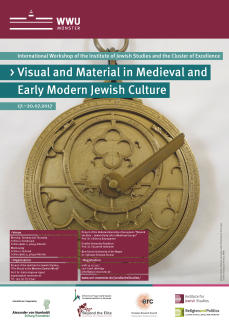“Visual and Material in Jewish Culture”
International workshop on the significance of images in Jewish culture

The significance of images in Jewish culture in medieval and early modern times is the subject of an international workshop of the Institute for Jewish Studies and the Cluster of Excellence “Religion and Politics” of Münster University. “Apart from the research carried out on the prohibition of images in the biblical Ten Commandments, there are currently hardly any insights on what influenced the Jewish attitude towards images and questions of visualisation”, scholar of Jewish Studies Prof. Dr. Katrin Kogman-Appel of the Cluster of Excellence, who organised the workshop, explains. Admittedly, numerous researchers have shown what role non-Jewish contexts played in the development of Jewish art. “However, we know little about how these interactions have shaped not only Jewish art, but also the inner-Jewish way of dealing with images and their significance for Jewish culture.”
The workshop “Visual and Material in Medieval and Early Modern Jewish Culture” (Visuelles und Materielles in mittelalterlicher und frühneuzeitlicher jüdischer Kultur) will take place in Münster from 17 until 20 July. Scholars from the USA, England, Germany and Israel will deal with the creation of images in Jewish culture and discuss forms of procurance as well as the use, function, and reception of images. “In addition to that, we want to find out what Jews saw on the streets of medieval Europe in their everyday life”, Humboldt Professor Kogman-Appel explains. This has opened up another research perspective which, until today, had hardly been given importance. “This does not only apply to the visual experiences on the street, but also to holy places such as synagogues or churches and the home.” The workshop specifically includes the material culture in the discussion on visual culture. “Thus, we hope to better understand the Jewish ways of perception and perspectives.”
Between Iconolatry and Iconoclasm
The scholars will look at the topic from various perspectives. They analyse texts from ritual law and responses and include philosophy, natural sciences, mysticism, exegesis and liturgical poetry. “We hope to gather insights on questions of iconolatry, iconoclasm, beauty, local culture and possible didactical functions of images and objects as well as their reception and rejection.”
Prof. Dr. Kogman-Appel arranges the workshop together with historian Prof. Dr. Elisheva Baumgarten of the Hebrew University in Jerusalem, scholar of Jewish Studies Prof. Dr. Elisabeth Hollender of Goethe University in Frankfurt am Main and historian Dr. Ephraim Shoham-Steiner of Ben-Gurion University of the Negev. At the Cluster of Excellence, Prof. Kogman-Appel heads the project B2-24 From Manuscript to Printing Press: The Illustrated Book in Jewish Culture (Fourteenth–Sixteenth Centuries)” (Von der Handschriftenkultur zum Buchdruck: das illustrierte Buch in der jüdischen Kultur des 14.-16. Jahrhundert).
Last year Prof. Dr. Katrin Kogman-Appel was awarded an Alexander von Humboldt Professorship. The Humboldt Professorship is the highest endowed- prize for scientific research in Germany and is granted by the Alexander von Humboldt Foundation to bring renowned researchers from abroad to Germany. Kogman-Appel is considered as one of the world's leading researchers in medieval Jewish art history. She, along with Prof. Dr. Regina Grundmann, heads the Institute for Jewish Studies that was founded in the summer of 2015 at the University of Münster. (dak/ill)

